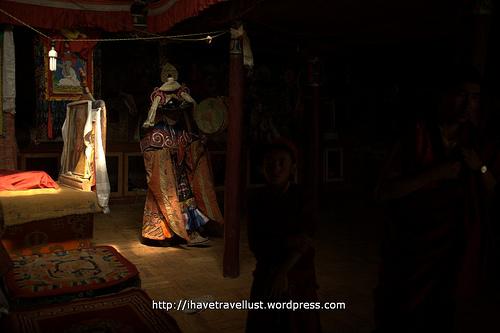ETHNOFLORENCE
INDIAN AND HIMALAYAN
FOLK AND TRIBAL ARTS
February 15, 2013
***

Mani Rimdu Festival Tukuche Nepal Mustang district in the Dhalawalagiri zone
MANI RIMDU FESTIVAL
TUKUCHE VILLAGE
NEPAL
***
Tukuche
spelt Tukche
is one of the villages of the
Mustang district in the Dhawalagiri zone of northern Nepal

The village is located in the
Kali Gandaki Gorge
Thakali people
Photo credit
of
Congochris Photostream

*

Mani Rimdu consists in a 19 day sequence of sacred ceremonies culminating in 3 day public festival.

The dances, performed by monks are regarded as sacred, and they can be ‘danced’ only in the context of the festival.

*

*

*

*

The Ceremony takes place from the first day of the tenth month of the Tibetan lunar calendar, normally falling between the mid of October and mid of November, during until the nineteenth day of the month.

The name of the dances are
Ser-Kyem, Ghing-Pa, Nga-Chhyama, Mi-Tsering, Rol-Cham, Thur-Dhag, Kang-Wa, Mi-Nak, Khandro, Tok-Den, Ngag-Pa, Ti-Cham, Lok-Cham (finishing Dance, that concludes the Mani Rimdu).

*

*

*

*

*

*

*

*

*

*

*

*

*

*

*

*

*

*

*

*

*

*

*

*

*

*

********************
Photo Credit
Congochris Photostream
************************************

Photo Ethnoflorence
*****************
****
(II)
BOOK OF THE WEEK
*
TRANS HIMALAYA
DISCOVERIES AND ADVENTURE IN TIBET
Sven Hedin
London
1909
********************************
Dancing Nepalese at the New Year Festival
Tashi-Lunpo

Nepalese performing symbolical dances at the New Year Festival


Lamas in dancing masks



*
Group of Masked (masks)

Lamas in Hemi Gompa

*

*
Strolling Musicians

*

*
Lama with Flute & Shell Trumpet, used in Religious Services

*

*
Reading Lama with Dorche and Drilbu
Lama with Prayer Drum

*

Photographic credit of http://www.archive.org
**********************
**********
*
(III)
FURER HAIMENDORF ARCHIVE
A WEEKLY SELECTION
********
MANI RIMDU
THAMI
Solukhumbu district
Nepal
1957

Joker with drum
Copyright
SOAS NICHOLAS HAIMENDORF
*
SOAS LIBRARY PPMS19_SHER_0202
*********

SOAS Library PPMS19_6_SHER_0209
*************************
SHERDUKPEN DANCERS IN ASSAM
1944
Belsiri River, Assam, Balipara District, India

SOAS Library PPMS_19_6_SHERD_0027
*
These masked dancers represent a demon in a Sherdukpen version of Aji Lhamu, a romance widely known in the Tibetan Buddhist world, including the neighbouring Monpas.

SOAS Library PPMS19_6_SHERD_0041

SOAS Library PPMS19_6_SHERD_0057
These wooden masked Sherdukpen dancers are figures in a version of a yak dance performed widely across the Tibetan Buddhist world. These figures are two of the three sons in the story, one of whom is dispossessed but later helped by a yak.

SOAS Library PPMS19_6_SHERD_0056
The masked man on the left represents the father of the two figures on the right.

SOAS Library PPMS19_6_SHERD_0052
The deer dance tells the story (of a hunter and his two sons and dog who trap a deer) as a parable about the immorality of killing animals.

SOAS Library PPMS_19_6_SHERD_0025
The figures, from right to left, are two queens, a king, a masked demon and two musicians.
********************
Copyright: SOAS, Nicholas Haimendorf
************
*****
**












































![3956373150_2f882550cd[1]](https://ethnoflorence.wordpress.com/wp-content/uploads/2010/02/81088-dyn006_original_500_333_pjpeg_2638188_30d7108d8899ac75cf64bbc873955c37.jpg)

![dyn003_original_604_453_pjpeg_2638188_beaf0638fb23a04c39845a9e1af070f8[1]](https://ethnoflorence.wordpress.com/wp-content/uploads/2010/02/dc7d1-dyn003_original_604_453_pjpeg_2638188_b522479c4a1fb26497b69f621ef58419.jpg)
![dyn007_original_425_640_pjpeg__0e15d3799f64cad284b2e15da398389b[1]](https://ethnoflorence.wordpress.com/wp-content/uploads/2010/02/2e80a-dyn003_original_425_640_pjpeg_2638188_97ce449acce6c0984aec1a4e734b7e75.jpg)



































![3219447461_555340329a[1]](https://ethnoflorence.wordpress.com/wp-content/uploads/2009/08/4f8b9-dyn003_original_500_333_pjpeg_2638188_255ce6ce058efa12542c293e07716c8b.jpg)
![3219449819_02b40a9ac3[1]](https://ethnoflorence.wordpress.com/wp-content/uploads/2009/08/4f460-dyn003_original_500_333_pjpeg_2638188_f73f7e875c39f59312362459fbccd9c3.jpg)
![3219455335_85c265e0dd[1]](https://ethnoflorence.wordpress.com/wp-content/uploads/2009/08/aa4f6-dyn003_original_500_333_pjpeg_2638188_1ae530d34ce4aab0b0506b5ce2b90e2c.jpg)
![3219457305_94a98654e8[1]](https://ethnoflorence.wordpress.com/wp-content/uploads/2009/08/1d7a7-dyn003_original_500_333_pjpeg_2638188_2f0b967f6bdd3c81cf46065544d11b03.jpg)
![3220295054_05bfca7f29[1]](https://ethnoflorence.wordpress.com/wp-content/uploads/2009/08/c783c-dyn003_original_500_333_pjpeg_2638188_230355cba5a94952b2b6dca826f40a7c.jpg)
![3220302538_e248c8a64d[1]](https://ethnoflorence.wordpress.com/wp-content/uploads/2009/08/4f5ba-dyn003_original_333_500_pjpeg_2638188_8f6bdf0d71dc52d9088c8b9c64ff1df6.jpg)
